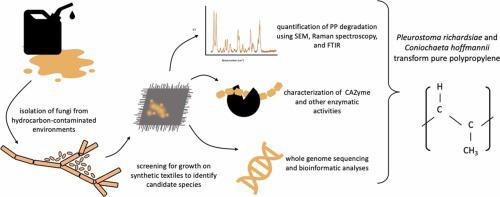Microbiological Research ( IF 6.1 ) Pub Date : 2023-09-27 , DOI: 10.1016/j.micres.2023.127507 Rachel Porter 1 , Anja Černoša 2 , Paola Fernández-Sanmartín 3 , Antonio Martínez Cortizas 3 , Elisabet Aranda 4 , Yonglun Luo 5 , Polona Zalar 2 , Matejka Podlogar 6 , Nina Gunde-Cimerman 2 , Cene Gostinčar 2

|
The urgent need for better disposal and recycling of plastics has motivated a search for microbes with the ability to degrade synthetic polymers. While microbes capable of metabolizing polyurethane and polyethylene terephthalate have been discovered and even leveraged in enzymatic recycling approaches, microbial degradation of additive-free polypropylene (PP) remains elusive. Here we report the isolation and characterization of two fungal strains with the potential to degrade pure PP. Twenty-seven fungal strains, many isolated from hydrocarbon contaminated sites, were screened for degradation of commercially used textile plastic. Of the candidate strains, two identified as Coniochaeta hoffmannii and Pleurostoma richardsiae were found to colonize the plastic fibers using scanning electron microscopy (SEM). Further experiments probing degradation of pure PP films were performed using C. hoffmannii and P. richardsiae and analyzed using SEM, Raman spectroscopy and Fourier transform infrared spectroscopy with attenuated total reflectance (FTIR-ATR). The results showed that the selected fungi were active against pure PP, with distinct differences in the bonds targeted and the degree to which each was altered. Whole genome and transcriptome sequencing was conducted for both strains and the abundance of carbohydrate active enzymes, GC content, and codon usage bias were analyzed in predicted proteomes for each. Enzymatic assays were conducted to assess each strain’s ability to degrade naturally occurring compounds as well as synthetic polymers. These investigations revealed potential adaptations to hydrocarbon-rich environments and provide a foundation for further investigation of PP degrading activity in C. hoffmannii and P. richardsiae.
中文翻译:

真菌 Coniochaeta hoffmannii 和 Pleurostoma richardsiae 降解聚丙烯
对更好地处理和回收塑料的迫切需要促使人们寻找能够降解合成聚合物的微生物。虽然已经发现了能够代谢聚氨酯和聚对苯二甲酸乙二醇酯的微生物,甚至在酶回收方法中得到了利用,但无添加剂聚丙烯 (PP) 的微生物降解仍然难以捉摸。在这里,我们报告了两种具有降解纯 PP 潜力的真菌菌株的分离和表征。筛选了 27 种真菌菌株,其中许多菌株是从碳氢化合物污染地点分离出来的,用于降解商用纺织塑料。使用扫描电子显微镜(SEM)发现,在候选菌株中,两个被鉴定为霍夫曼Coniochaeta hoffmannii和Pleurostoma richardsiae 的菌株在塑料纤维上定殖。使用霍夫曼梭菌和理查氏 P.进行了进一步的实验,探究纯 PP 薄膜的降解,并使用 SEM、拉曼光谱和衰减全反射傅里叶变换红外光谱 (FTIR-ATR) 进行分析。结果表明,所选真菌对纯 PP 具有活性,其目标键和每个键的改变程度存在明显差异。对这两种菌株进行了全基因组和转录组测序,并在预测的蛋白质组中分析了碳水化合物活性酶的丰度、GC 含量和密码子使用偏差。进行酶测定以评估每种菌株降解天然存在的化合物以及合成聚合物的能力。这些研究揭示了对富含碳氢化合物环境的潜在适应,并为进一步研究C. hoffmannii和P. richardsiae的 PP 降解活性奠定了基础。













































 京公网安备 11010802027423号
京公网安备 11010802027423号